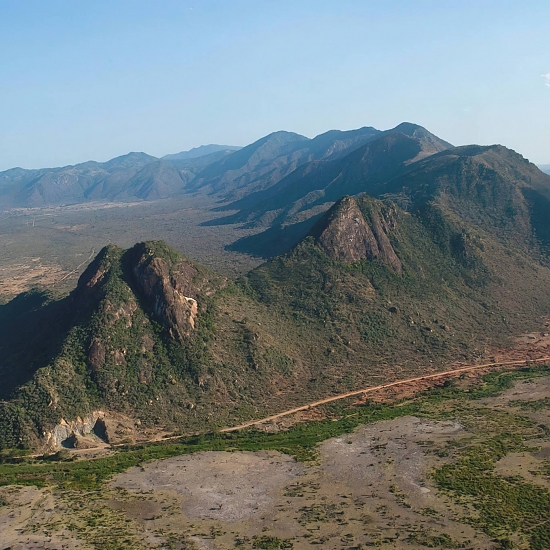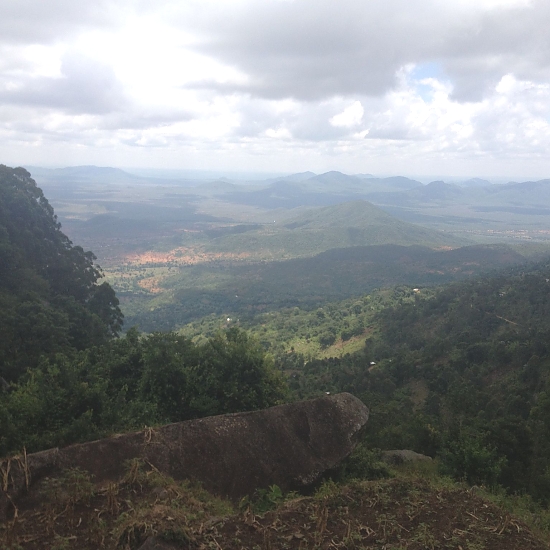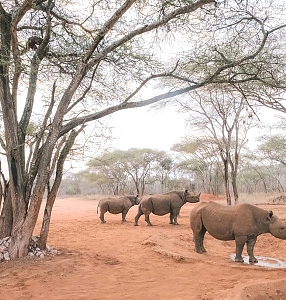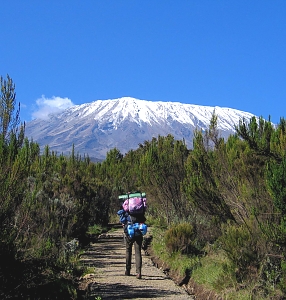Pare Mountains
Pare Mountains
The Pare Mountains are a collection of peaks located in northeastern Tanzania. The range is divided up into northern and southern subranges, both of which are part of the Eastern Arc Mountains. Within the range, there are 52 named mountains, the highest and most prominent of which is Shengana Peak (2,463 m/8,081 ft) in South Pare.
The North Pare Mountains and the South Pare Mountains are located in northeastern Tanzania. They begin about 35 km (20 mi) to the southeast of Kilimanjaro and end just to the north of the Usambara Mountains. To the east of the North Pare Mountains is Lake Jipe, which is located on Tanzania’s border with Kenya.
The North Pare Mountains in the Mwanga District of the Kilimanjaro Region contain six forest reserves: Kindoroko, Minja, Mramba, Kiverenge, Kamwella I, and Kamwella II. In total, these reserves cover 7,407 ha (18,303 acres) of terrain. In addition to this, there are nearly 300 clan forests that protect 371 ha (917 acres) of land in the region.
The South Pare Mountains are located in the Same District of the Kilimanjaro Region. Within the southern part of the range you’ll find:
- 1 Nature Reserve – Chome Nature Reserve
- 8 Gazetted Forest Reserves – Chambogo, Kiranga-Hengae, Chongweni, Kankoma, Kisiwani, Vumari, Kwizu, and Maganda
- 5 Proposed Forest and Village Forest Reserves – Kwamwenda, Mwala, Dido, Mambugi, and Ishereto
In total, these reserves cover more than 27,168 ha (67,134 acres) of terrain.
Chome Nature Reserve encompasses 14,283 ha (35,294 acres) of land in the Pare Mountains, including Shengena Peak, the tallest mountain in the range. It was established as a forest reserve in 1957 and upgraded to a nature forest reserve in 2016.
Geology
The mountains in the Eastern Arc began forming around 100 million years ago. They reached a topography that’s somewhat similar to their current state at the start of the Miocene epoch about 25 to 30 million years ago.
The rocks in the range date back to the Precambrian epoch but have since been deformed from millions of years of uplift and erosion. The Eastern Arc Mountains are primarily composed of migmatites and granites, with some significant quartz veins running through them. Shengena Peak and the surrounding mountains in the South Pare are rich in mica deposits.
Ecology
The Pare Mountains are generally considered to be of lower conservation priority than other sections of the Eastern Arc Mountains due to their lower levels of endemism.
The South Pare Mountains support a range of habitats including sub-montane, montane, and upper montane, as well as areas of montane heath within the Chome Nature Forest Reserve.
Some of the trees that you’ll find in the South Pare Mountains include Guinea plum (Parinari excelsa) in sub-montane forests, and Ocotea usambarensis, Albizia gummifera, and Podocarpus latifolius in montane forests. The South Pare white-eye (Zosterops winifredae) is a bird species that’s endemic to the range.
The mountains receive approximately 140 cm (55 in) of rain per year, primarily in the short rainy season that occurs in November and December and in the long rainy season from March through May.
Threats to forests in this part of the range have come from logging for valuable timber species and fires. When fires damage existing forests in the region, invasive trees like black wattle and Eucalyptus grow in. Oftentimes, these invasive species out-compete the range’s native flora.
The North Pare Mountains encompass montane forests, dry montane forests, dry woodlands, and heathlands. Some of the primary tree species that you’ll see in this part of the range include African cherry (Prunus africana), Albizia gummifera, and Newtonia buchananii. This part of the range is relatively dry when compared to other forests within the Eastern Arc.
There are approximately three endemic vertebrate species and three endemic plant species in the Pare Mountains. There have not been many biodiversity surveys done (particularly on reptiles, amphibians, and plants) in the region. The forests of the Pare Mountains support a wide network of fauna and Hundreds of birds thrive in the Pare Mountains, including hawks, buzzards, eagles, shrikes, flycatchers, warblers, thrushes, and sunbirds. Genets, civets, mongoose, Syke’s monkeys, hyraxes, duikers, bushbucks, yellow baboons, elephant shrews, and other rodents can be found throughout the forests of the range, too.
Human History
Pareland is also known as Vuasu (Asu the root word and Chasu or Athu, the language). The location lies on one of the northern routes for historic east-African long-distance trade, connecting the hinterland with the coast of the Indian Ocean. The residents of northern Pare recognise two sub-areas based on ethno linguistic differences: Gweno-speaking Ugweno to the north and Chasu-speaking Usangi to the south.
To the Pare tribe, also called the Wapare, the mountains in this range have been home for at least 500 years. While many tribes in Tanzania today have begun to forgo traditional practices and adopt more urbanized lifestyles, the Pare are known for upholding their tribal traditions.
Traditional practices and knowledge continue to be shared within the Pare tribe to this day. This sharing of cultural knowledge and practices has helped conserve much of the region’s forests because many of them are considered sacred to the Pare. The Pares continue to practice traditional customs, such as collecting plants from within the region’s forests for medicinal uses and other cultural purposes.
Chome Nature Forest Reserve & Shengena Peak
Shengena Peak is the highest mountain in the Pare Mountains, so it is understandably one of the region’s main attractions.
The two-hour drive from the town of Same to Chome Nature Forest Reserve is the route most commonly used to access Shengana Peak. There is also a visitor center for the reserve located just outside of Same. An alternative route to the forest reserve from Makanya approaches from the highway that’s situated to the south of Same.
Chome has two campsites, one of which is located inside the reserve and one of which is situated by the reserve’s entrance. Hikers can also find accommodations at local guest houses in Kisaka and in the other villages that border the reserve.
The hike to the top of Shengena Peak takes an average of six hours to complete. From the summit, hikers can enjoy panoramic views of Mkomazi National Park and Taita Hills, both of which are located across the border in Kenya.
Destinations near Pare Mountains
These nearby destinations have a lot to offer














